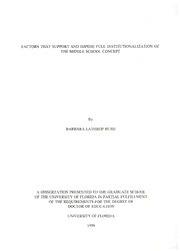Table Of ContentFACTORSTHATSUPPORTANDIMPEDEFULLINSTITUTIONALIZATIONOF
THEMIDDLESCHOOLCONCEPT
By
BARBARALATHROPBUSH
ADISSERTATIONPRESENTEDTOTHEGRADUATESCHOOL
OFTHEUNIVERSITYOFFLORIDAINPARTIALFULFILLMENT
OFTHEREQUIREMENTSFORTHEDEGREEOF
DOCTOROFEDUCATION
UNIVERSITYOFFLORIDA
1999
ACKNOWLEDGMENTS
Writingadissertationmaybeanindividualaccomplishment,butitisajoint
effort.Thisresearchwouldnothavebeencompletedwithouttheguidanceandsupportof
mycommitteeandtheemotionalsupportofcolleaguesandfamilymembers.
IamindebtedtoDr.PhillipClark,mycommitteechair.Heguidedmethroughthe
journeyofdissertationresearchandkeptmefocused.Iamalsoappreciativeoftheadvice
providedbyDr.PaulGeorgeregardingmiddleschoolorganizationandqualitative
research.IthankDr.JamesDoudandDr.EugeneToddfortheirencouragementand
assistance.
Iamgratefultomycolleaguesandcohortmembers,VirginiaAbernathyand
SharonVoorhees.Theyactedaseditorsbothincontentandsyntax.
Ithankmyparentsfortheirsupport.Myfather,GordonLathrop,instilledinmea
loveofeducation.Itwashewhoseededmycommitmenttoearnadoctoraldegree.My
mother,BeulahLathropMartins,providedtheextrinsicmotivationthroughherconstant
andcontinualsupport.Iamtheirlegacy.
Aboveall,Iamindebtedtomyhusband,MichaelBush.Hesupportedmeand
mademanysacrificesduringthe5yearsofmydoctoralprogram.Heencouragedmeat
thelowpointsandcelebratedwithmeeachtimeIreachedabenchmark.Thisdegreeis
his,too.
n
5917991
TABLEOFCONTENTS
page
ACKNOWLEDGMENTS ii
LISTOFTABLES vii
ABSTRACT viii
CHAPTERS
1 INTRODUCTION 1
StatementoftheProblem 1
PurposeoftheStudy 12
GlossaryofTerms 12
DelimitationsandLimitations 1
Delimitations 15
Limitations 15
SignificanceoftheStudy 16
OrganizationoftheDissertation 1
2 LITERATUREREVIEW 1
HistoryoftheMiddleSchoolOrganization 1
TheDevelopmentoftheJuniorHighSchool 1
TheDemiseoftheJuniorHighSchool 23
TheEmergenceoftheMiddleSchool 24
DevelopmentoftheMiddleSchoolintheStateofFlorida 28
DevelopmentalNeedsofMiddleSchoolStudents 31
AdolescentGrowthandDevelopment 3
PhysicalDevelopment 34
EmotionalDevelopment 36
SocialDevelopment 37
CognitiveDevelopment 39
TheoreticalPerspective 40
MiddleSchoolTheory 40
AdvisoryPrograms 46
iii
InterdisciplinaryTeamingOrganization 51
ExploratoryClasses 55
FlexibleScheduling;ActiveInstruction;SpeciallyTrainedTeachers 58
Flexiblescheduling 58
Activeinstruction 58
Speciallytrainedteachers 60
SharedDecisionMaking 62
SuccessfulStudentExperiences 63
HealthandPhysicalEducation 64
ReconnectingwithHomeandCommunity 66
NeedforFurtherMiddleLevelResearch 68
3 METHODOLOGY 77
Introduction 77
QualitativeResearch 77
ResearchDesign 78
MethodsandProcedures 80
SamplingandDescriptionoftheSubject 80
Observation 82
Interview 83
Documents 85
DataManagement 86
DataAnalysis 88
ValidityandReliablity 89
InternalValidity 89
ExternalValidity 91
Reliability 91
InvestigatorBias 93
EthicalIssues 94
Summary 95
4 RESULTS 99
Introduction 99
Interviewee'sBackgrounds,Experiences,andTraining 100
Observations 108
DocumentsandWrittenRecordsCollected 108
ResearchQuestion1 119
Interviews 120
Observations... 123
DocumentsandWrittenReports 125
IV
ResearchQuestion2 130
InterdisciplinaryTeamingOrganization 132
Interviews 132
Observations 140
Documentsandwrittenrecords 141
ExploratoryProgram 142
Interviews 142
Observations 147
Documentsandwrittenreports 147
SuccessfulStudentExperiences 149
Interviews 149
Observations 155
Documentsandwrittenrecords 157
HealthandPhysicalEducationProgram 161
Interviews 161
Observations 166
Documentsandwrittenreports 167
ResearchQuestion3 168
AdvisoryProgram 169
Interviews 169
Observations 179
Documentsandwrittenreports 181
FlexibleScheduling.ActiveTeaching,andSpeciallyTrainedTeachers 182
Interviews 182
Observations 191
Documentsandwrittenreports 195
SharedDecisionMaking 199
Interviews 199
Observations 203
Documentsandwrittenreports 205
HomeandCommunityConnection 207
Interviews 207
Observations 212
Documentsandwrittenreports 214
Summary 217
5 CONCLUSIONS,IMPLICATIONS,ANDRECOMMENDATIONS 221
OverviewoftheStudy 221
Conclusions 228
SupportingFactors 228
ImpedingFactors 231
v
Implications 236
RecommendationsforFutureStudy 245
APPENDIX INTERVIEWGUIDE 247
REFERENCES 250
BIOGRAPHICALSKETCH 258
vi
11
LISTOFTABLES
Table page
4-1 Participants'Backgrounds 101
4-2 ChronologicalListingofObservations 109
4-3 DocumentsandWrittenRecordsCollected 11
4-4 MSA'sMOECSurveyResults 117
4-5 NumberofTimesComponentswereListedinSchoolScrapbook 127
4-6 NumberofTimesComponentswereListedin"WeeklyBulletins" 128
4-7 NumberofTimesComponentswereListedinParents'Corner 129
4-8 Participants'ResponsestoFullInstitutionalizationofComponentsQuestions 13
4-9 ResultsoftheSafetyandDisciplineSurvey 159
4-10ResultsofTheNationalStudyofDelinquencyPreventioninSchools:Teacher
Reports 160
4-11ResultsofCRESTMiddleSchoolStaffSurvey 162
4-12CTBSMedianPercentileTestScoresforMSA's8thGradeCohort 198
4-13SharedDecision-MakingOpportunities 206
4-14SupportingFactorsofFullyInstitutionalizedPractices 218
4-15FactorsImpedingFullInstitutionalizationofPractices 220
vii
AbstractofDissertationPresentedtotheGraduateSchool
oftheUniversityofFloridainPartialFulfillmentofthe
RequirementsfortheDegreeofDoctororEducation
FACTORSTFIATSUPPORTANDIMPEDEFULLINSTITUTIONALIZATIONOF
THEMIDDLESCHOOLCONCEPT
By
BarbaraLathropBush
December1999
Chairman:PhillipA.Clark
MajorDepartment:EducationalLeadership,Policy,andFoundations
Thepurposeofthisstudywastoidentifythefactorsthatsupportorimpedethe
fullinstitutionalizationofthemiddleschoolconcept.Casestudyresearchwasemployed
withdescriptivemethodsofdatacollection.MiddleSchoolAwasselectedasthe
boundedunitsince(a)themiddleschoolconcepthadbeenineffectfor12years,(b)a
cadreoffacultymembershadbeenonsitesinceimplementationofmiddleschoolreform,
and(c)thestudentbodyhadbeenrecognizedforacademicachievement.Threequestions
directedtheresearch.
1. Whichexemplarymiddleschoolpracticeshavebeensuccessfullyimplementedin
MiddleSchoolAintheyearssinceitopened?
2. Whichoftheseexemplarypracticescontinuetobesuccessfullyimplementedin
MiddleSchoolA?Whatsupportfactorshaveenabledthesepracticestocontinue?
viii
3. WhichoftheseexemplarypracticeshavebeendiscontinuedatMiddleSchoolA?
Whatsupportfactorswerediscontinuedtoallowthistohappen?
Interviewsandobservationswereheldwhiledocumentsandwrittenreportswere
reviewedovera5-monthperiodinthe1998-1999schoolyear.Categoricalcodingand
analysiswereemployedusingacomputerized,textual,data-basemanager.Datawerefirst
sortedbycodesreferencingtheeightexemplarymiddleschoolpracticesidentifiedinthe
literaturereview.Datawerere-codedbasedonpatternsofsupportingandimpeding
factorsthatemerged.
Factorsfoundmostinfluentialincluded(a)dedicatedfacultymembers,
(b)school-basedadministrativesupport,(c)practicesmandatedandsupportedbythe
stateand/orschooldistrict,and(d)students’needsandattitudes.Factorsfoundmost
impedingincluded(a)teacherresistance;(b)lackoftraining;(c)timemanagement;
(d)accountabilityissues,curriculumstandards,andmandatesfromthestateand/or
county;(e)negativestudentbehavior;(f)classsize;and(g)changesinschool-based
leadership.
Thisresearchisimportantasitwillaidmiddleschooladministratorstorecognize
thefactorsinfluencingthefullinstitutionalizationofthepracticesofanexemplarymiddle
school.School-basedmiddleschoolleaderswillbeabletodevelopstrategiestoreduceor
eliminateconditionsthatimpedethisprogress.District-leveladministratorswillbeableto
proactivelycreatestrategiesthatapplysupportingfactorsasnewmiddleschoolfacilities
arebeingestablished.
K
CHAPTER
1
INTRODUCTION
Earlyadolescentsareinamultitransitionalstageoflife.Theygothroughpuberty,
begintoidentifymorewithpeersthanfamily,developtheabilitytothinkabstractly,and
transferfromtheprimarilyself-containedenvironmentfoundintheelementaryschoolto
thelargerimpersonalsecondaryschool.Itisatthistimeearlyadolescentsstartmaking
long-lastingpersonalandeducationaldecisions(Hargreaves,Earl.&Ryan.1996).
Mostresearchers(e.g..George&Alexander,1993;Scales,1996:Stevenson.1992;
Toepftr.1992;Wavering,1995)identifyearlyadolescenceasoccurringduringages10
through14or10through15.Theagesaremoreapproximatethanexactsincenotwo
childrenenterearlyadolescenceatthesametimeorprogressatanequalrate(Milgram,
1992).'Thecentraldifficultyencounteredindescribingyoungadolescentsisthat
althoughsomegeneralizationsmaybemadeaboutselecteddimensionsofchangethey
undergo,thereisnotypicalyoungster”(Stevenson,1992,p. 10).Dorman,Lipsitz,and
Verner(1985)summarizedadolescentgrowthanddevelopmentwiththefollowing:
Earlyadolescenceisatimeofrapidgrowthandchangeasyoungpeople
beginthephysicalandsocialtransitionfromchildhoodtoadulthood.
Socially,youngadolescentsbegintoseparatefromtheirparents,testtheir
developingsenseofautonomy,establishclosepeerrelationships,and
reachoutbeyondthefamilytoconnectwithalargersocialsphere.They
alsobegintodevelopthecognitiveability'tothinkabstractly,tothink
seriouslyabouttheirpersonalfuturesinrelationtotheirsocialcontext,and
toreflectonsocialandpersonalvaluesandmotives.Thesechangescome
I

